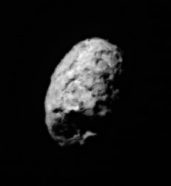Catching a Comet’s Tail
A closeup visit by a NASA spacecraft helps show how a comet gets its shape.
Share this:
- Share via email (Opens in new window) Email
- Click to share on Facebook (Opens in new window) Facebook
- Click to share on X (Opens in new window) X
- Click to share on Pinterest (Opens in new window) Pinterest
- Click to share on Reddit (Opens in new window) Reddit
- Share to Google Classroom (Opens in new window) Google Classroom
- Click to print (Opens in new window) Print
It’s been a bumpy ride for the spacecraft known as Stardust.
On Jan. 2, the NASA craft got within 240 kilometers of the core of a comet known as Wild 2 (pronounced Vilt 2). The region around the comet’s core is a blizzard of dust and debris. As the spacecraft passed through this dusty storm, it felt the impact of particles traveling six times as fast as a rifle bullet.
But Stardust’s shields held up, and the craft did its job. It scooped up some samples of the dust and took photos of the comet’s core. They’re the sharpest, most detailed pictures yet taken of a comet, says Donald E. Brownlee of the University of Washington in Seattle.
 |
|
Comet Wild 2, as recorded by the Stardust spacecraft on Jan. 2, has a rounded shape and a surface covered with craterlike hollows. One hemisphere is in sunlight, the other in shadow.
|
| Donald Brownlee, et al./JPL/NASA |
The photos, sent back to Earth by radio, showed that Wild 2 is an unusual comet. First, Wild 2 doesn’t have the peanut shape typical of other comets astronomers have observed. It’s spherical. Also, Wild 2 is not as smooth as some of its cousins. Instead, its surface is pitted with craterlike hollows.
Mike Belton of Tucson, Ariz., thinks this is because Wild 2 hasn’t been around the block enough times. In other words, it hasn’t made many trips to the inner solar system.
When a comet’s journey through the solar system brings it closer to the sun, the solar heat turns some of the compounds on the comet’s icy surface into vapor. These vaporized substances escape the comet’s surface as jets of gas, forcing out other kinds of debris along with them. All this shedding of material changes both the comet’s overall shape and the texture of its surface.
The peanut-shaped comet Halley has visited the inner solar system more than 1,000 times. It’s gone through many episodes of heating and shedding. In contrast, Wild 2 has been in the inner solar system only five times. The more time it spends close to the sun, the more its shape will change.
Stardust has now left Wild 2 to begin the 1.14-billion-kilometer journey back to Earth. The craft is expected to arrive, bearing its cargo of comet dust—and probably more than a few dents—in January 2006.







